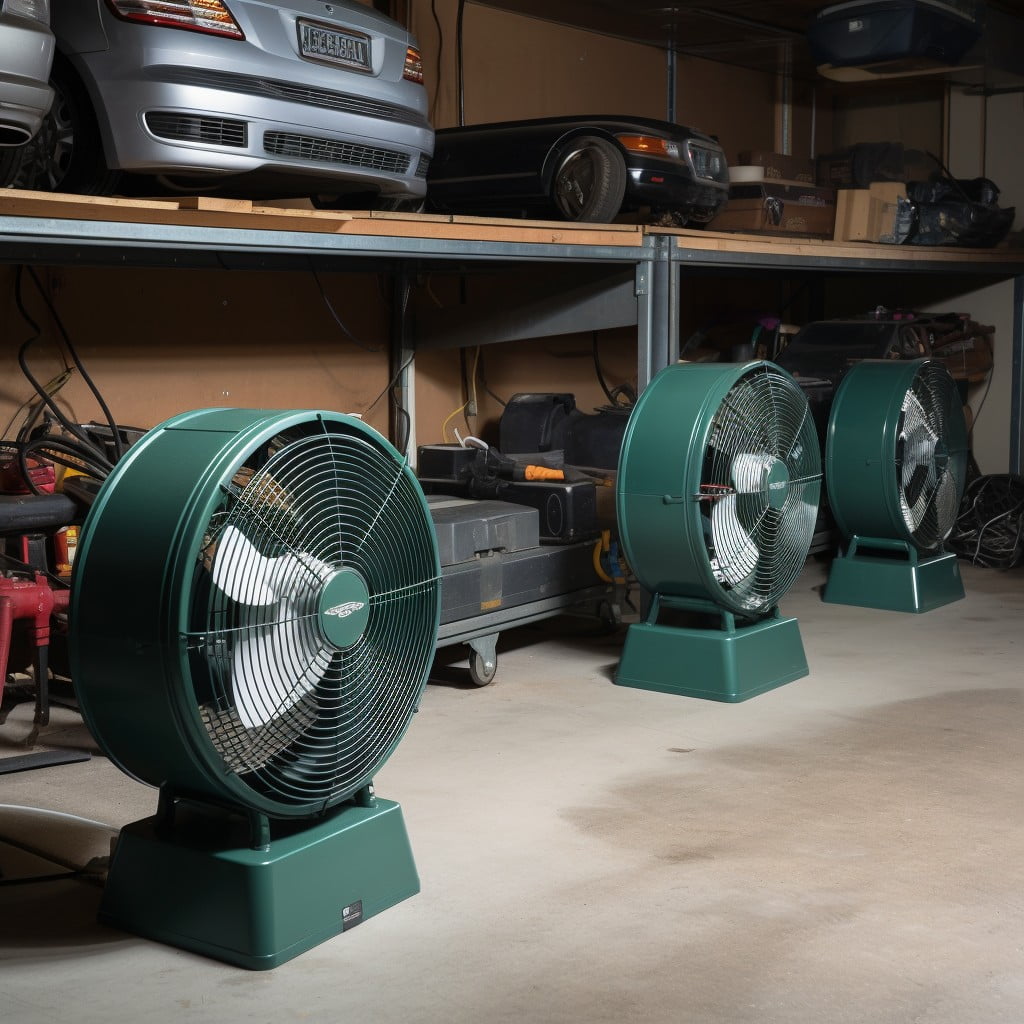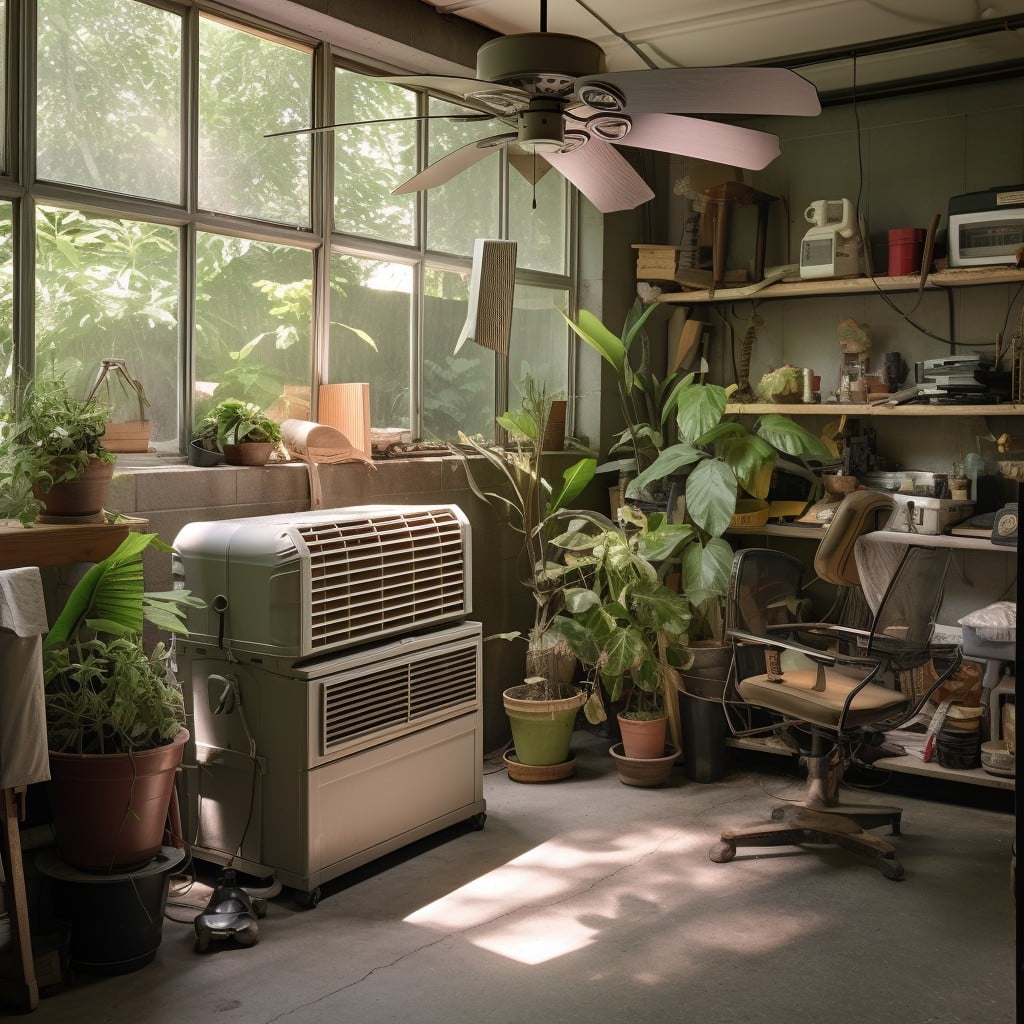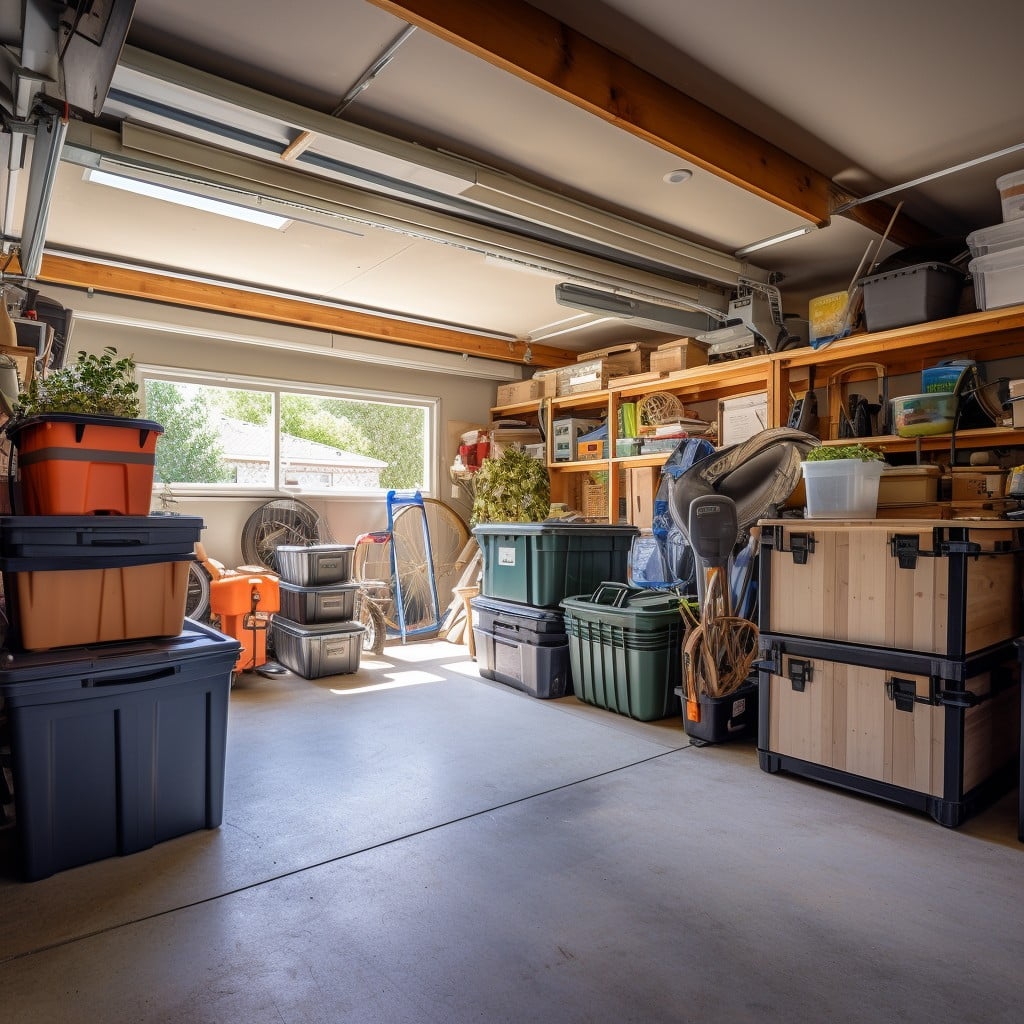Explore effective strategies for cooling a garage without windows, from insulation improvements to portable air conditioning units.
Keeping a garage cool without windows might seem like a tricky task, but it’s entirely possible with the right strategies. Whether you’re dealing with sweltering summer heat or a stuffy workspace, there are several effective methods to lower the temperature.
From insulation and ventilation to portable air conditioners and dehumidifiers, this article will guide you through the best solutions to maintain a comfortable temperature in your windowless garage. So, if you’re looking for a comprehensive guide to cooling your garage, you’re in the right place.
Stay tuned for detailed steps and tips to help you create a cooler and more productive environment.
Key takeaways:
- Determine cooling requirements based on garage size, heat-producing equipment, and insulation.
- Use portable fans strategically and maintain them properly.
- Consider using a swamp cooler for efficient cooling.
- Reduce clutter to improve airflow and reduce heat buildup.
- Insulate walls, ceiling, and garage door to keep the temperature low.
Determining the Amount of Cooling Required for Your Garage Without Windows

To accurately gauge the amount of cooling necessary, it’s key to take into consideration a few factors.
First, the size of your garage. A larger space will demand more cooling, while a smaller space will require less. It might be helpful to measure the amount of square footage to have a precise understanding.
Second, the amount of heat-producing equipment. Power tools, refrigerators or other machinery contribute to higher temperatures.
Lastly, assess the garage’s insulation. Poor insulation allows more external heat to enter, while effective insulation keeps it out, affecting how much additional cooling will be needed. These critical factors not only aid in selecting the right cooling method, but also play a significant role in reducing excessive energy consumption.
Selecting and Using Portable Fans for Garage Cooling

There are several types of portable fans suitable for garage cooling, each with its own characteristics. Bladeless fans, for instance, deliver a smooth flow of cool air, making them ideal for small garages. On the other hand, industrial fans are powerful, capable of cooling extensive areas and ideal for large garages. Some even have misting options to increase cooling effectiveness.
The positioning of the fan is crucial. Place it in a strategic location where it can cool the entire garage and not just one area. For maximum cooling, the fan should be angled upwards to circulate air throughout the garage.
In addition to selection and placement, maintenance of portable fans should not be overlooked. Cleaning your fan regularly can prevent dust accumulation, maintain optimal performance and increase the lifespan of your fan.
Using a Swamp Cooler for Effective Garage Cooling

A swamp cooler, also known as an evaporative cooler, works by evaporating water to cool the air, making it an environmentally-friendly, energy-efficient option. It’s particularly effective in dry climates and can lower your garage’s temperature significantly.
To best utilize a swamp cooler, position it near the door that leads into your house or a vent for maximum circulation, if such opening exists. Fill it with water, plug it into a power source, and choose the desired setting. Most swamp coolers come with adjustable speed levels, allowing you to balance the dampness and temperature.
Remember that an evaporative cooler increases humidity, it is an excellent idea to regularly monitor your garage to prevent any mold or rust from developing on tools or vehicles. Most modern swamp coolers are easy to maintain, requiring only regular water refills and occasional pad replacements. Making use of a swamp cooler can surely contribute to a more comfortable atmosphere in your windowless garage.
Reducing Clutter to Cool Your Garage

Clearing the garage of unnecessary items can significantly improve airflow, helping to reduce the ambient temperature. Stacks of boxes or large unused items can obstruct the passage of air, trapping heat.
While arranging your garage, here are a few points to consider:
- Ensure the garage floor is not crowded – it makes a considerable difference in improving airflow.
- Frequently used items should be stored on shelves or hung on the walls. This leaves the center of the garage clear, allowing air to circulate freely.
- Try to maintain open spaces around any machinery that generates heat, such as a refrigerator or power tools. This increases heat dispersion, reducing overall temperatures.
- If possible, try to remove as many heat-producing items from the garage. Alternatively, where such removal isn’t practical, consider insulating them to minimize heat gain.
- Old paint cans, chemicals, and other flammable or hazardous materials not only clutter the garage but can also increase the risk of overheating. Safe disposal can be key in cooling your garage space.
Remember, a de-cluttered garage is not just cooler, but it can be a more functional and safer workspace too.
Installing a Garage Ventilation Fan for Permanent Cooling
Beginning with the consideration of placement, not all spots are created equal. Ideally, a ventilation fan should be installed in the highest possible location, typically the upper section of a wall, as hot air naturally rises. The installation of an exhaust fan encourages consistent air movement and extraction.
Bear in mind the fan size. Larger garages might need a higher capacity fan to circulate air effectively. Always refer to the manufacturer’s guidelines to ascertaining the appropriate fan size for your garage.
Power supply is next up. Ensure there’s a nearby power source or plan for installing additional electrical circuitry to power the fan.
In terms of control, while manual operation may offer simplicity, opting for a thermostatically controlled fan may help maintain a more consistent temperature.
Lastly, don’t overlook safety. Ensure the fan installation follows local building codes and wiring standards, and isn’t positioned where it could pose a danger, especially when working with potentially flammable materials in the garage.
Remember, a ventilation fan should be part of a larger cooling strategy, working in harmony with other methods like air circulation and insulation.
The Impact of Wall, Ceiling & Garage Door Insulation On Garage Temperature
Insulating the walls, ceiling, and door of your garage is a strategic way to keep the temperature low, offering a two-fold approach. For one, it helps to prevent the heat from the outside getting into the garage. Secondly, it locks in the cooler air inside, stopping it from escaping.
Here are a few key points to remember:
- 1. Use Rigid Foam Panels: These are available in varying thicknesses and are ideal for insulating walls and ceilings. Be sure to seal the edges to avoid air passage.
- 2. Consider Insulated Garage Doors: These specialized doors are designed with an insulating material within the panels.
- 3. Don’t Forget Weather Stripping: Ensuring a tight seal around the door will help keep cool air in and warm air out.
- 4. Consider Radiant Barriers: When applied to ceilings and attic spaces, this shiny, reflective material can significantly reduce radiant heat gain.
Remember, the better-insulated your garage is, the easier it is to control the temperature. Even without windows, such insulation techniques can make your garage a more comfortable space, saving on potential cooling costs in the long term.
Replacing Incandescent Bulbs to Reduce Heat
It’s often overlooked, but the type of lighting used in your garage can significantly contribute to the overall heat. Conventional incandescent light bulbs emit considerable heat when turned on. Ideally, switching to more energy-efficient alternatives such as LED or compact fluorescent bulbs can make a marked difference. Besides producing less heat, these options consume less electricity and offer a longer lifespan.
Take the following into account:
- LED Bulbs: These have significantly cooler operation temperatures because they efficiently convert energy to light with only a tiny fraction becoming heat. Besides, they are highly durable and energy-efficient.
- Compact Fluorescent Bulbs: Commonly called CFLs, they use around 70% less energy than incandescent bulbs. While they also convert energy efficiently and produce less heat, they might not be as cool as LEDs.
- Energy Star-Certified Bulbs: Ensure your new bulbs are Energy Star-certified for better efficiency. While the upfront cost might be higher, you would save more in the long run due to reduced electricity bills and replacement costs.
Remember, safety comes first when doing electrical work. Always switch off power at the main switch before making any replacements.
Importance of Increasing Air Circulation in a Garage With No Windows
Air circulation is a key factor in cooling your garage. Devoid of natural airflow due to the lack of windows, it becomes crucial to implement measures to increase this aspect artificially.
1. Utilize Fans: Strategically placed fans can aid greatly in circulating cool air in your garage. Position them at different heights or angle them towards the ceiling to create a breeze that moves hot air around.
2. Install Air Vents: Air vents on the garage door or walls can play a significant role in maintaining air movement. These allow hot air to escape, making way for cooler air.
3. Use Ventilation Blocks: On the lower and upper sections of your garage walls, you can install ventilation blocks to encourage airflow.
4. Determine Direction of Airflow: Ensure that there is a clear path for the airflow. Remove objects that might obstruct the directional flow of the fan or vent.
5. Experiment with Fan Speeds: Different fan speeds may yield different results. Try various speeds to identify the one that optimizes air circulation effectively.
Remember, improving air circulation will go a long way in maintaining a comfortable temperature in your garage.
Creating Shade Inside a Garage Without Windows
There are several ways of casting shade inside your garage for temperature management. The key is to block heat before it penetrates the interior.
1. Use of garage door screens: A popular and effective method. These can both allow fresh air in and prevent direct sunlight from heating the space.
2. Reflective material: Available in rolls, it’s easy to cut for any size. Sticking them on the garage door can bounce back heat keeping the interiors cooler.
3. Sunshade sail: Secured outside, above the garage, it blocks solar radiation while providing an aesthetic appeal.
4. Insulated garage door: Although a pricier investment, insulating your door will turn it into a barrier against both summer heat and winter cold.
Implementing these shading methods can greatly reduce the inflow of heat, making your garage a more comfortable space to work in, even without windows. However, it is essential to consider combining shading with other cooling systems for the best outcome.
Choosing a Climate Control System for a Garage Without Windows
With the right climate control system, maintaining your garage’s temperature becomes a breeze even without windows. Consider systems like mini-split air conditioners or garage-specific HVAC units when weighing your options.
The mini-split system comes with an outdoor compressor and an indoor air-handling unit. They are cost-effective, energy-efficient, and easy to install. On the other hand, garage-specific HVAC units are designed to withstand the harsh conditions often encountered in garages, such as chemical fumes or dust.
Consider factors such as the size of your garage, the average outside temperature, and the insulation level of your garage doors and walls before making a selection. Having these details at hand will guide your decision towards an option that best suits your needs. Additionally, consult with a professional installer to ensure a smooth, effective installation process. Remember, a well-cooled garage not only increases your comfort but also extends the lifespan of stored items and vehicles.
FAQ
How do you circulate air in a garage without windows?
To circulate air in a garage without windows, installing exhaust vents is an effective method as they facilitate air circulation and help dissipate fumes and odors.
Can you use a portable AC in a garage without a window?
Yes, a portable AC can be used in a garage without a window due to its compact size and ability to function effectively without the need for window installation.
What are some effective insulation techniques for a windowless garage to regulate temperature?
Effective insulation techniques for a windowless garage include applying spray foam or fiberglass insulation to walls and ceilings, installing weather stripping on doors, and using insulating paint.
How can a dehumidifier aid in cooling a garage without windows?
A dehumidifier can aid in cooling a garage without windows by removing excess moisture from the air, thereby reducing the area's overall temperature.
Which fans work best for ventilating and cooling a windowless garage?
Industrial fans, exhaust fans, or a garage ventilation system are often the best solutions for ventilating and cooling a windowless garage.